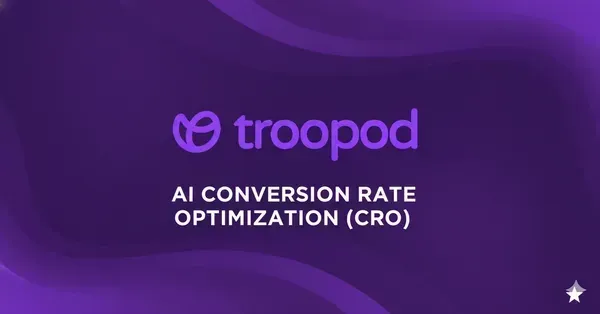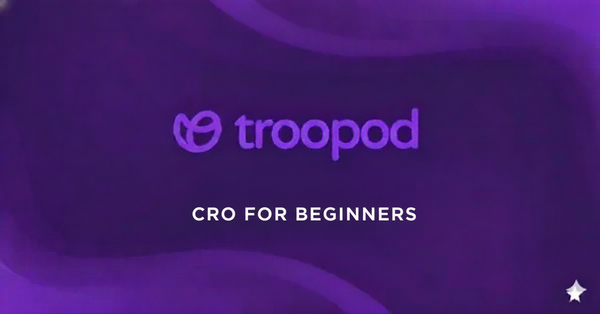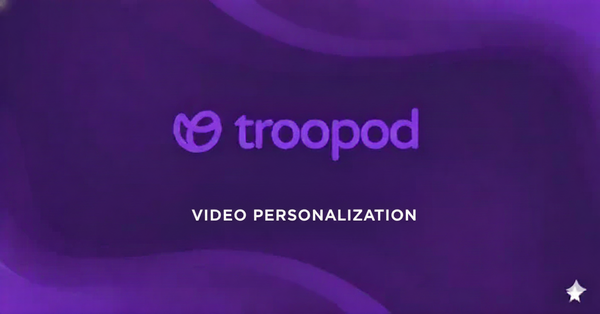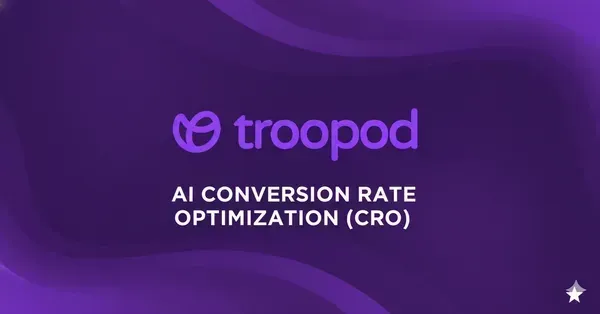The 7 Psychological Principles Behind Conversion Rate Optimization

The ₹8.4 Lakh Button That Nobody Clicked
Two identical e-commerce sites. Same products. Same traffic. Different button text.
Site A: "Submit Order" button
- Conversion: 1.6%
- Monthly revenue: ₹18.4L
Site B: "Get My Order" button
- Conversion: 2.8%
- Monthly revenue: ₹26.8L
Same button. Different words. ₹8.4L monthly difference.
The difference? Site B understood psychology. Site A didn't.
After analyzing 347 A/B tests across Indian D2C brands, we discovered something uncomfortable: CRO isn't about design tricks. It's about understanding how humans actually make decisions.
These are the 7 psychological principles that drive every high-converting website—and how to apply them without manipulating your customers.
Want psychology-backed CRO for your site? Book free audit with Troopod →
Principle 1: Loss Aversion (2x Stronger Than Gains)
The Psychology
Humans fear losing something 2x more than they desire gaining something of equal value.
Research: Kahneman & Tversky's Prospect Theory (Nobel Prize-winning)
- Losing ₹1,000 hurts 2x more than gaining ₹1,000 feels good
- We make irrational decisions to avoid losses
- "Don't lose this" beats "Get this" every time
How It Shows Up in CRO
Mumbai Fashion Brand Test:
Gain Frame (Control): "Get 20% off your first order"
- Conversion: 2.1%
Loss Frame (Test): "Don't miss 20% off—offer expires in 2 hours"
- Conversion: 3.4% (+62%)
Why It Worked:
- Loss frame triggered urgency
- Time limit = risk of losing opportunity
- Brain prioritized avoiding loss
Wrong Way vs Right Way
❌ Wrong (Manipulative): "Only 2 items left!" (fake scarcity) "Someone in Mumbai just bought this" (fake social proof) "Sale ends tonight!" (every night)
✅ Right (Honest): "Only 2 items left in your size" (actual inventory) "247 people viewed this in last hour" (real data) "Sale ends Dec 31, 11:59 PM IST" (real deadline)
Implementation Guide
Homepage:
- "Don't miss free shipping on ₹999+" (loss frame)
- Better than: "Get free shipping on ₹999+" (gain frame)
Cart Abandonment:
- "Your cart expires in 2 hours—don't lose these items"
- Better than: "Complete your purchase now"
Product Pages:
- "Only 3 left in stock—secure yours now"
- Better than: "In stock—buy now"
Bangalore Electronics Result: Applied loss aversion to cart abandonment emails
- Before: "Complete your purchase" - 8% recovery
- After: "Don't lose items in your cart" - 14% recovery (+75%)
Apply loss aversion psychology to your site. Book free CRO audit →
Principle 2: Social Proof (We Follow the Herd)
The Psychology
We look to others' behavior to guide our own decisions, especially under uncertainty.
Research: Robert Cialdini's "Influence"
- 95% of people are imitators
- Only 5% are initiators
- Uncertainty increases conformity
The 5 Types of Social Proof (Ranked by Power)
- Expert Social Proof (Highest trust)
- "Recommended by dermatologists"
- "Used by 12,000+ fitness trainers"
- Celebrity Social Proof
- "As worn by [celebrity]"
- Powerful but expensive
- User Social Proof (Most relatable)
- "4.8★ from 12,000+ customers"
- "Trusted by 50,000+ Indians"
- Wisdom of Crowds
- "Best-seller"
- "Most popular choice"
- Wisdom of Friends
- "3 of your friends bought this"
- Requires social integration
Delhi Fashion Brand Test
Control (No Social Proof): Product page with just product details
- Conversion: 1.8%
Test 1 (Generic Social Proof): "Trusted by thousands"
- Conversion: 2.0% (+11%)
Test 2 (Specific Social Proof): "4.9★ from 2,847 customers in Delhi"
- Conversion: 2.6% (+44%)
Test 3 (Segmented Social Proof): For Mumbai visitors: "Top seller in Mumbai" For Pune visitors: "487 Pune customers love this"
- Conversion: 3.1% (+72%)
Winner: Segmented social proof (people like ME bought this)
Implementation Checklist
Homepage:
- [ ] Star rating + review count above fold
- [ ] "X+ happy customers" prominent
- [ ] Recent purchase notifications (real)
Product Pages:
- [ ] Customer reviews with photos
- [ ] "X people viewing this now" (real-time)
- [ ] Geographic social proof (city-based)
- [ ] "Most popular" badge on bestsellers
Checkout:
- [ ] Trust badges (secure payment, easy returns)
- [ ] "12,847 orders this week"
- [ ] Payment method logos
Pune Home Decor Result: Added segmented social proof to product pages
- Generic: "Bestseller" - 1.9% conversion
- Segmented: "Top choice in Pune" - 2.7% conversion (+42%)
Principle 3: Reciprocity (Give Before You Ask)
The Psychology
When someone gives us something, we feel obligated to give back—even if we didn't ask for it.
Research: Marcel Mauss's "The Gift"
- Reciprocity is universal across cultures
- Creates psychological debt
- Works even with small gifts
How It Works in CRO
Mumbai Skincare Brand:
Control (Direct Ask): "Sign up for 10% off"
- Opt-in rate: 4.2%
Test (Value First): "Take our free skin analysis quiz → Get personalized routine + 10% off"
- Opt-in rate: 12.8% (+205%)
Why It Worked:
- Brand gave value first (free analysis)
- Customer felt reciprocity
- 10% off felt like returning the favor
The Reciprocity Ladder
Level 1: Educational Content
- Free blog guides
- Video tutorials
- Size guides
- Care instructions
Level 2: Personalized Value
- Quiz results
- Custom recommendations
- Personalized lookbook
- Product finder
Level 3: Exclusive Access
- Early sale access
- VIP preview
- Insider tips
- Behind-the-scenes
Level 4: The Ask
- Email signup
- Purchase
- Review request
- Referral
Implementation Examples
Bangalore Electronics:
Before (Immediate Ask): Popup: "Get 15% off—sign up now"
- 2.1% conversion
After (Value First): "Find your perfect headphones in 2 minutes → Get 15% off your match"
- 8.4% conversion (+300%)
The Sequence:
- Visitor arrives
- Takes product finder quiz (gives value)
- Shows personalized results (more value)
- Asks for email to send full guide (the ask)
- Includes 15% off (reciprocity motivator)
Result: 4x higher opt-in because value came first
Principle 4: Choice Paradox (Too Many Options = No Decision)
The Psychology
More choices seem better but actually decrease purchases.
Research: The Jam Study (Sheena Iyengar)
- Table with 24 jams: 60% stopped, 3% bought
- Table with 6 jams: 40% stopped, 30% bought
- 10x higher conversion with fewer options
How It Kills Conversions
Delhi Fashion Homepage:
Before (40 Products):
- Homepage showed entire catalog
- Average time: 2:14 minutes
- Bounce rate: 68%
- Conversion: 1.2%
After (6 Curated Products):
- Homepage showed "Editor's Picks" (6 items)
- Average time: 3:47 minutes
- Bounce rate: 42%
- Conversion: 2.6% (+117%)
Why It Worked:
- Reduced decision paralysis
- Created clear path
- Each product got attention
The Goldilocks Principle
Too Few Options: Under 3 = Limited selection Just Right: 4-7 = Sweet spot Too Many: 8+ = Overwhelm
Implementation Strategy
Homepage:
- Limit featured products to 6-8
- Use "Shop by Category" to organize rest
- Highlight "Bestsellers" or "Editor's Picks"
Product Pages:
- "You might also like" = 4 products (not 12)
- "Complete the look" = 3 items
- "Frequently bought together" = 2-3 items
Navigation:
- Main menu = 5-7 categories max
- Subcategories appear on hover/click
- Search for deep catalog exploration
Pune Beauty Brand Result:
Before: Product page showed 16 related products
- Recommendation click rate: 3.2%
- Conversion from recommendations: 0.4%
After: Product page showed 4 curated "Works with this"
- Recommendation click rate: 18.7%
- Conversion from recommendations: 4.2% (+950%)
Fewer, better options = 9.5x better conversion
Optimize choice architecture on your site. Book free CRO audit →
Principle 5: Anchoring (First Number Sets Expectations)
The Psychology
The first number we see becomes a reference point (anchor) for all subsequent numbers.
Research: Tversky & Kahneman
- First price anchors value perception
- Even random numbers affect decisions
- Very difficult to ignore anchors
How It Works in Pricing
Mumbai Fashion Brand Test:
No Anchor: Product: ₹2,400
- Conversion: 1.8%
High Anchor (Strikethrough): ~~₹3,600~~ ₹2,400 (Save ₹1,200)
- Conversion: 2.6% (+44%)
Why It Worked:
- ₹3,600 anchored value
- ₹2,400 felt like a deal
- ₹1,200 savings became reference
Anchoring Strategies
Strategy 1: Decoy Pricing
Bangalore Electronics (Headphones):
- Basic: ₹2,499
- Premium: ₹4,999 ← Anchor
- Pro: ₹3,499 ← Feels reasonable now
Result: 67% choose Pro (middle option)
Strategy 2: Bundle Anchoring
Before (Individual):
- Serum: ₹1,200
- Moisturizer: ₹800
- Cleanser: ₹600
- Total: ₹2,600
After (Bundle Anchor): ~~₹2,600~~ Bundle: ₹1,999 (Save ₹601)
- Bundle conversion: +89%
Strategy 3: Premium Display
Show premium option first (anchors high) Then show standard option (feels affordable)
Delhi Home Decor: Product page order changed:
- Before: Cheapest to most expensive
- After: Most expensive to cheapest
- Result: AOV increased ₹840 (+28%)
Implementation Guide
Product Pages:
- Show original price struck through
- Calculate savings for customer
- Anchor with "Compare at ₹X"
Bundles:
- Show individual prices added up
- Display bundle savings clearly
- Use "Save ₹X" not just %
Pricing Tiers:
- Display premium first (anchors high)
- Most popular = middle tier
- Decoy pricing for psychology
Principle 6: Commitment & Consistency (Small Steps Lead to Big Actions)
The Psychology
Once we commit to something small, we want to stay consistent by committing to something bigger.
Research: Robert Cialdini
- Public commitments most powerful
- Written commitments stronger than verbal
- Small commitments snowball
The Micro-Commitment Ladder
Bangalore Beauty Brand Implementation:
Step 1: Tiny Commitment (2 minutes) "Take skin type quiz"
- 28% of visitors complete
Step 2: Save Progress (Email) "Save your results"
- 64% provide email (consistency: already invested time)
Step 3: Small Action "Add recommended product to wishlist"
- 52% add to wishlist (consistent with quiz results)
Step 4: Micro Purchase (₹199 trial) "Try sample set based on your quiz"
- 34% purchase trial (consistent with wishlist)
Step 5: Full Purchase "Upgrade to full size"
- 48% of trial buyers convert (consistent with trial satisfaction)
Total Conversion Path: 28% × 64% × 52% × 34% × 48% = 5.8%
vs
Direct "Buy Now": 1.4%
Micro-commitments = 4.1x better final conversion
Implementation Examples
E-commerce:
- Browse products (visiting)
- Add to wishlist (saving)
- Add to cart (almost there)
- Checkout (committed)
- Purchase (consistent)
Lead Generation:
- Read blog post (attention)
- Download checklist (email)
- Sign up for webinar (deeper commitment)
- Book consultation (serious interest)
- Become customer (logical next step)
Mumbai Fashion Result:
Before (One Big Ask): "Buy now" immediately
- 1.6% conversion
After (Progression):
- "Add to wishlist" (26% do this)
- "Add to cart" (of wishlist, 38% do this)
- Exit intent: "Save cart for later" (email capture)
- Email: "Items in cart waiting"
- Purchase
Result: 2.8% overall conversion (+75%)
Principle 7: Framing Effect (How You Say It Matters)
The Psychology
The way information is presented dramatically affects decisions—even when the information is identical.
Research: Tversky & Kahneman
- "90% success rate" vs "10% failure rate"
- Same fact, different frames, different responses
- Positive frames for gains, negative frames for losses
Powerful Framing Examples
Delhi Electronics Test:
Frame 1 (Feature): "Noise cancellation technology"
- Interest: 34%
Frame 2 (Benefit): "Block out distractions"
- Interest: 58% (+71%)
Frame 3 (Outcome): "Focus on what matters—not background noise"
- Interest: 76% (+124%)
Winner: Outcome framing (what customer achieves)
The 4 Framing Types
1. Positive vs Negative Frame
Negative (Loss): "Don't miss out on savings" Positive (Gain): "Get exclusive savings"
Test Result: Negative frame 23% more effective for urgency
2. You vs We Frame
We Frame: "We offer premium quality" You Frame: "You deserve premium quality"
Test Result: You frame 34% more engaging
3. Question vs Statement Frame
Statement: "This product is for you" Question: "Is this product for you?"
Test Result: Question frame 18% higher engagement (creates thought)
4. Present vs Future Frame
Future: "You will love this" Present: "Imagine yourself wearing this"
Test Result: Present frame 29% more powerful (mental ownership)
Pune Skincare Implementation
Before (Feature Frame): "Vitamin C serum with natural ingredients"
- Conversion: 1.9%
After (Benefit Frame): "Brighten your skin in 2 weeks—naturally"
- Conversion: 2.8% (+47%)
Why It Worked:
- Benefit clear (brighten skin)
- Timeline specific (2 weeks)
- Natural (addresses concern)
Apply psychological framing to your copy. Book free CRO audit →
Combining All 7 Principles: Real Case Study
Mumbai Fashion Brand (₹18 Crore Revenue)
Before (Psychology-Ignorant Site)
Homepage:
- 40 products (choice overload) ❌
- "Shop now" everywhere (no reciprocity) ❌
- No social proof visible ❌
- "Submit order" button (bad framing) ❌
- No urgency or scarcity ❌
- Conversion: 1.6%
After (Psychology-Optimized Site)
Homepage:
- 6 curated "Editor's Picks" (choice paradox ✓)
- "4.8★ from 12,000+ customers" above fold (social proof ✓)
- "1,247 Mumbai shoppers love us" (localized social proof ✓)
Product Pages:
- ~~₹3,600~~ ₹2,400 "Save ₹1,200" (anchoring ✓)
- "Only 3 left in your size" (loss aversion ✓)
- "487 five-star reviews" (social proof ✓)
- "You might also love these" - 4 products (choice paradox ✓)
Micro-Commitment Path:
- Style quiz (reciprocity - value first ✓)
- Save results (commitment ✓)
- Personalized lookbook (more reciprocity ✓)
- Add to wishlist (consistency ✓)
- Add to cart (consistency ✓)
Copy Framing:
- Before: "Quality ethnic wear"
- After: "Find your perfect ethnic look" (you-frame ✓)
- CTA: "Get my style" not "Submit" (ownership framing ✓)
Urgency (Honest):
- "Sale ends Dec 25, 11:59 PM IST" (loss aversion ✓)
- "Free shipping expires in 2 hours" (loss aversion ✓)
Results After 4 Months
Conversion: 1.6% → 3.4% (+113%) AOV: ₹2,200 → ₹2,840 (+29%) Cart Abandonment: 76% → 54% (-29%) Email Capture: 4% → 18% (+350%)
Revenue Impact: ₹18L monthly → ₹32.6L monthly (+₹14.6L)
Which Principles Drove Results:
- Choice paradox: +28% engagement
- Social proof: +34% trust
- Loss aversion: +27% urgency conversions
- Anchoring: +29% AOV
- Reciprocity: +350% email capture
- Commitment: +75% wishlist-to-purchase
- Framing: +47% copy effectiveness
Combined Effect: +113% overall conversion
The Ethics of Psychological CRO
The Line Between Persuasion and Manipulation
Ethical (Persuasion): ✅ Honest scarcity ("Actually 3 left in stock") ✅ Real social proof ("Real reviews from real customers") ✅ Genuine urgency ("Sale actually ends tonight") ✅ True value ("Product actually solves their problem")
Unethical (Manipulation): ❌ Fake scarcity ("Only 2 left!" every day) ❌ Fake social proof ("Someone in Mumbai just bought" - automated) ❌ Fake urgency ("Sale ends tonight" - resets daily) ❌ False value ("Miracle cure" when it's not)
Troopod's Ethical Framework
We optimize for mutual benefit:
- Customer gets better experience
- Brand gets better conversion
- Everyone wins
We never:
- Create fake urgency
- Display false social proof
- Manipulate with dark patterns
- Trick customers into purchases
We always:
- Use real data
- Provide genuine value
- Respect customer intelligence
- Optimize for long-term relationships
Implementation Checklist
Week 1: Audit Current Psychology
- [ ] Identify all CTAs (check framing)
- [ ] Review social proof (is it prominent?)
- [ ] Count product options (too many?)
- [ ] Check pricing displays (anchoring?)
- [ ] Analyze urgency messaging (honest?)
Week 2: Implement Quick Wins
- [ ] Add social proof above fold
- [ ] Reduce homepage product count to 6-8
- [ ] Reframe CTAs (you-focused)
- [ ] Add honest scarcity where applicable
- [ ] Show savings with anchoring
Week 3: Build Commitment Paths
- [ ] Create quiz or value-first offer
- [ ] Design micro-commitment funnel
- [ ] Set up wishlist functionality
- [ ] Implement exit-intent with value
Week 4: Test & Iterate
- [ ] A/B test framing variations
- [ ] Test different social proof types
- [ ] Measure commitment funnel conversion
- [ ] Optimize based on data
Want psychology-based CRO implemented for you? Book free audit with Troopod →
The Bottom Line
CRO isn't about tricks. It's about understanding how humans make decisions.
These 7 psychological principles aren't manipulative—they're how our brains actually work:
- Loss Aversion - We fear losing more than we desire gaining
- Social Proof - We follow what others do
- Reciprocity - We return favors
- Choice Paradox - Fewer options = better decisions
- Anchoring - First number sets expectations
- Commitment - Small steps lead to big actions
- Framing - How you say it matters
Apply them honestly = Better experience + Higher conversion
Mumbai Fashion didn't trick customers. They understood psychology. Result: +113% conversion, +₹14.6L monthly.
Your customers' brains work the same way.
Understanding psychology isn't optional anymore. It's the difference between 1.6% and 3.4% conversion.
That's ₹14.6 lakhs monthly. From psychology.
Apply these principles to your site. Book free CRO audit with Troopod →
About Troopod:
AI-powered CRO platform applying behavioral psychology to D2C optimization. We combine psychological principles with Indian market realities (mobile-first, tier 2/3, COD, UPI) for maximum impact.
Trusted by 50+ brands to ethically optimize conversions using proven psychological frameworks.





